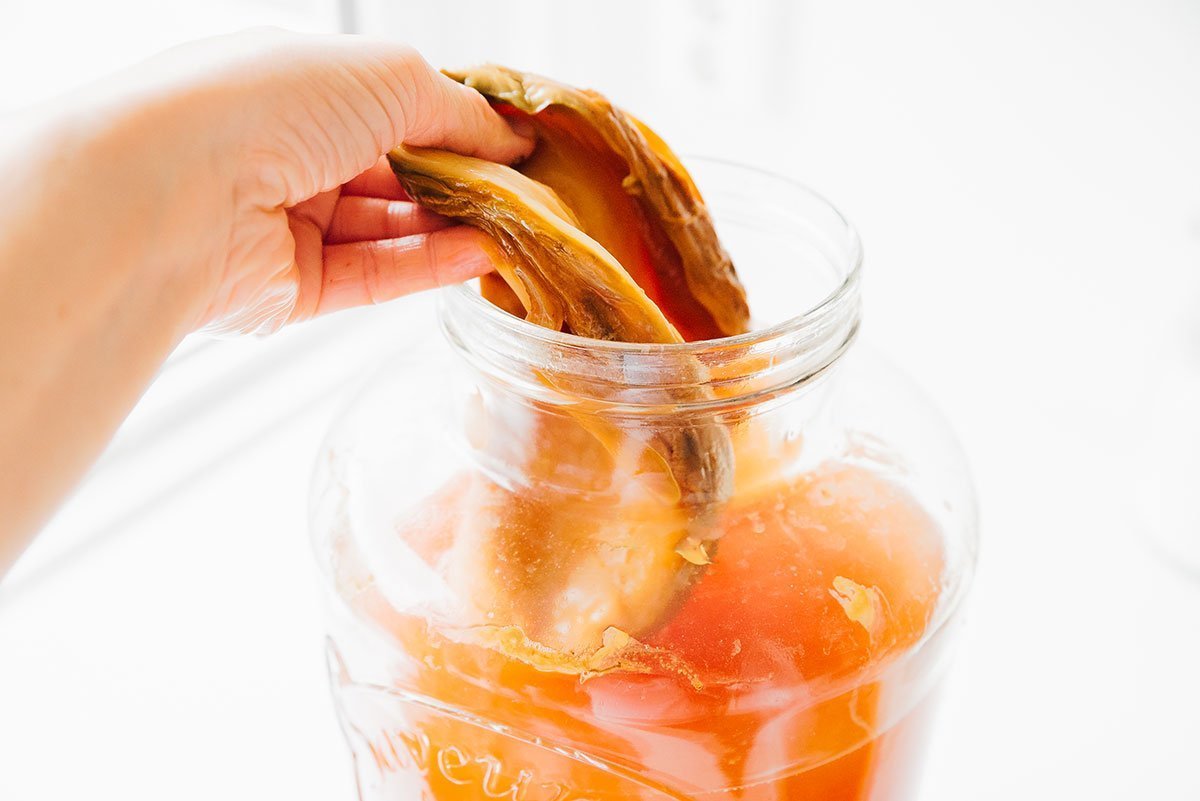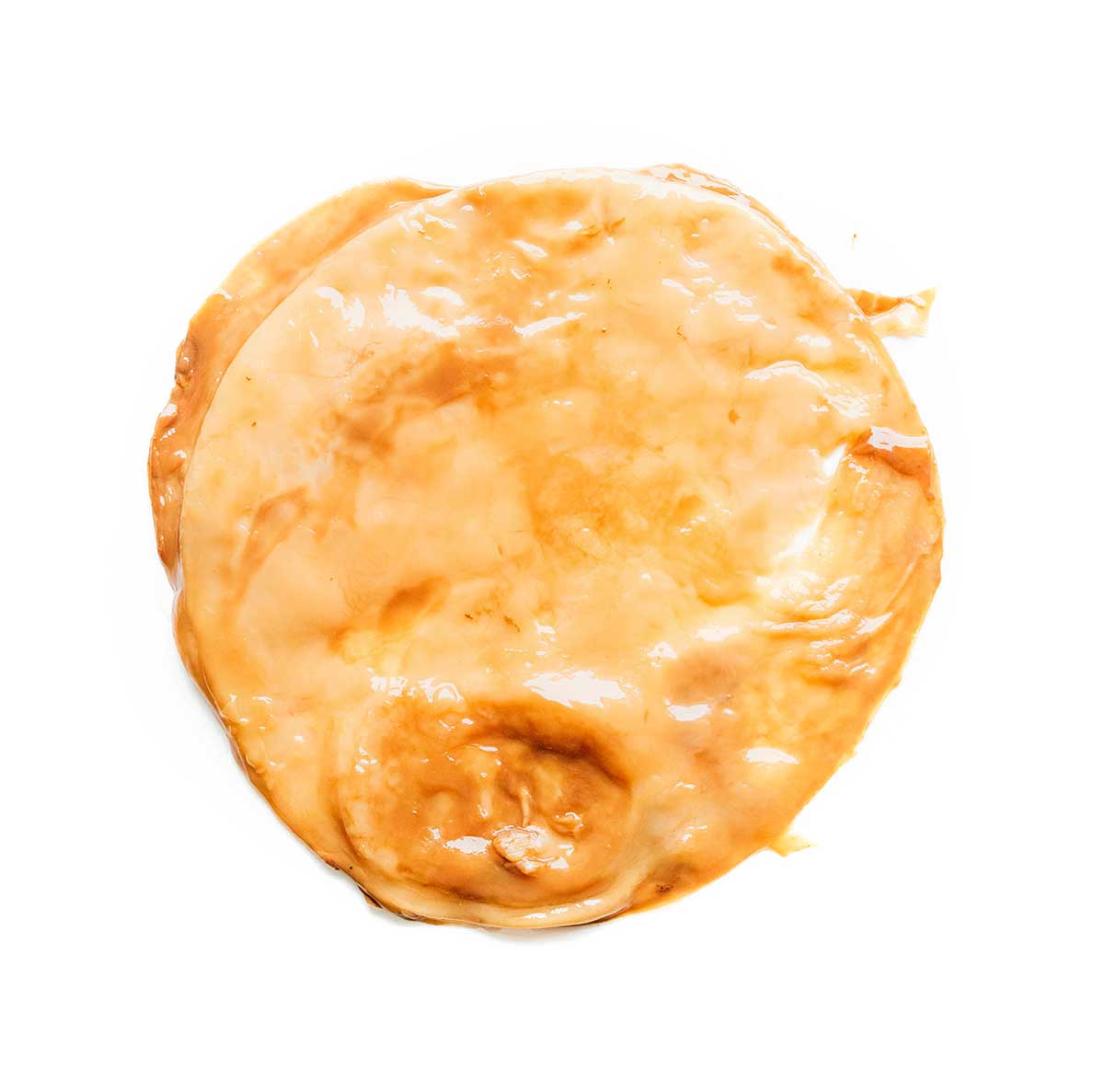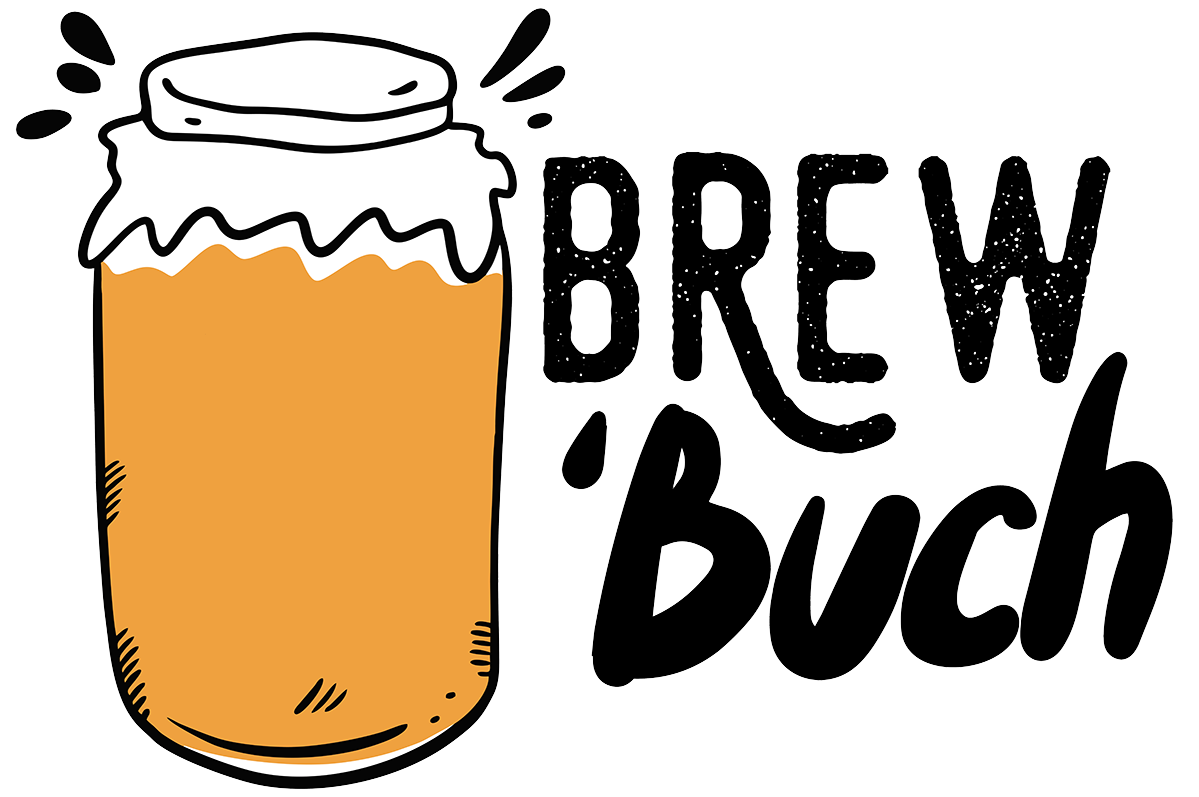A home brewed kombucha expert, I’m often asked what is a SCOBY? And is it the same as mother in kombucha? Or kombucha pellicle? We’re answering everything you need to know about homemade kombucha SCOBYs here!

There’s a good chance if you show an uninitiated non-brewer your own kombucha, they’ll be instantly turned off by that thing growing on top. I mean, it is gross right?
But once you’ve churned out your first delicious batches of kombucha, you’ll have a newfound love for your kombucha mother (so much so that you might even decide to eat the SCOBY)!
What is a kombucha SCOBY?
SCOBY is an acronym that stands for Symbiotic Culture Of Bacteria and Yeast. While you’ll most often see it referred to as a SCOBY, it also goes by “kombucha mother”, “kombucha mushroom”, or “pellicle”. But they all basically mean the same thing – the kombucha starter.
So how does a SCOBY work? The name says it all. Bacteria and yeast working together symbiotically n a fermentation process to transform sweet tea into kombucha. The yeast in the SCOBY eat the sugars in your kombucha, transforming them into ethanol. The bacteria feed on this ethanol, turning it into acidity and giving kombucha its distinctively sour taste.
The bacteria also feed on some of the sugar, producing cellulose as a result. This cellulose builds up to form the thick, rubbery SCOBY layer!
The kombucha mother is just another word for the SCOBY, because it is the catalyst to the fermentation.
As kombucha ferments, it will continue to make more and more SCOBYs, either making one large SCOBY or sometimes many small SCOBY babies.
Can you eat a SCOBY? Yes! The SCOBY is made if edible cellulose, and can be added to smoothies or used to make jerky or candy.
“I had always understood the concept of SCOBY as explained in this article UNTIL I started following several Facebook groups. They had convinced me that the SCOBY is actually the liquid, and the cellulose mat is a pellicle. So now I’m confused all over again.”

What should my scoby look like?
SCOBYs are like snowflakes; no two are the same! Room temperature, humidity, ingredients, brew vessels, and age can all impact how your SCOBY grows and looks.
Some SCOBYs will be perfectly white and round, while others will be brown and sludgy (the brown stringy bits on bottom are simply yeast – nothing to worry about, but you can double check with these pictures of kombucha mold to be sure). There’s no “perfect SCOBY”!
Did your SCOBY sink? That’s totally fine! Learn more about sunken SCOBYs here.

Can you grow your own scoby?
Contrary to popular belief, you don’t need to buy a SCOBY to get started. You can make a new SCOBY at home with just black tea, sugar, and pre-made kombucha.
The pre-made kombucha (either from a friend or the store bought beverage) contains the bacteria and yeasts needed to get started, and will produce a SCOBY in 1 to 4 weeks. Just be sure to use a starter kombucha that doesn’t have added flavors! Get the full guide to making your SCOBY here.
How to use a SCOBY
Once you have a SCOBY, you can start brewing kombucha with it! You’ll essentially just mix together tea, sugar, and pre-made kombucha, then add your SCOBY. The SCOBY jumpstarts fermentation while creating a seal over the brew to prevent contaminants from coming in. Get the full guide to brewing kombucha here.
When your SCOBY isn’t in use (like if you have extras or need to take a break), plop them into a SCOBY hotel. Here’s how to make a five star SCOBY hotel!
SCOBYs don’t have a shelf life and can live virtually forever if fed and cared for regularly.
Feed a SCOBY by regularly placing it in a solution of sweetened tea.


Hi. I’m brand new to kombucha brewing. My scoby is huge, taking most of the jar, and smells vinegary at day five. What am I doing wrong?
That’s all completely normal! You can divide up your SCOBY and get rid of some to slow down the fermentation a bit if you want to.
I received my scoby in the mail. I ordered it from Etsy. It said I could keep it at room temperature sealed in the same container for weeks. I had a family emergency and its been three weeks. Do you think it’s ok? Thank you! Deb
It’s probably okay, yes!
I have followed your “grow your scoby” instructions and it’s time for my first brew (maybe even more like 1/2″ scoby). I was wondering if I could save my scoby growing tea in a different jar and allow it to maybe keep growing scobies? or use it to store scobies my 1st batches make.
2nd issue-how do I keep gnats off my scobies/kombucha in the late summer? This last year I had it covered with cheese cloth and it got a lot of gnats or fruit flies in it, so I chucked it out 🙁
Thank you for all your kombucha advice!
Yes you can keep that tea and let it keep fermenting! It’s a great starter tea for future batches 😀 And here’s our guide to preventing fruit flies in kombucha. Happy brewing!
I had always understood the concept of SCOBY as explained in this article UNTIL I started following several Facebook groups. They had convinced me that the SCOBY is actually the liquid, and the cellulose mat is a pellicle. So now I’m confused all over again.
I’ve been successfully brewing for about 8-9 years. For the last 3 years, I’ve been sharing SCOBY with acquaintances and even posting on Nextdoor to share my bounty. Prior to Covid, I would do short brewing lessons in my home and send people off with everything they needed to get started, along with bottles of F2 for them to watch and finish.
I just wish I knew for certain that I’m getting new brewers off to a good start with accurate terminology.
Hi Linda! Give this article a read – it goes into that confusing terminology! 😀
Hi. Thank you for sharing!! Is it OK to use flavored store bought kombucha to start your SCOBY?!
Thanks !
Hi Melissa! You’ll want to find unflavored kombucha – the flavored stuff could cause mold. Here are some tips for finding unflavored kombucha!
Hey Sarah,
I’m using a fermentation cap with the ability to take the air out of the jar, like with use for making fermented vegetables, is that ok, or is it better to let some O2 into the fermentation process with kombucha?
With kombucha you’ll want to let some O2 in, so just cover with a cloth 😀
Is there any problem with using a coffee filter for long-term storage of the mini scoby hotel? Should I double up on filters or am I overthinking this?
Thanks!
1 coffee filter should be good!
What great question … and answers! I’ve made several batches of kombucha & enjoy drinking it after the second fermentation which is when I add slices of peeled ginger root. It’s not as fizzy as store bought. Next batch I’ll try a bit of honey.
Thanks for such an informative website.
Hi Ingrid! Check out this article to help troubleshoot the lack of carbonation. Happy brewing!
Wonderful! Thank you
Is it ok to store my SCOBY in the refrigerator between brewings? I made my first batch and got a great SCOBY, but I made enough to drink for a few weeks. I didn’t brew another batch yet because I have been busy and ordered new ingredients. So I stored the SCOBY in an air tight glass container, in the fridge. SCOBY still looks great.. I’m just making sure it’s going to work once I brew my next batch.
No it’s best to leave it out at room temp with a cloth covering. . Details on how to store a SCOBY here!
I made my first batch of kombucha, saved my scope for the next batch, but my liquid is just about got, evaporation, or maybe I didn’t save enough liquid. Anyway, would it still be okay to use, bottom is moist, top of it is white, don, t see any mold.
Also, I have no left over kombucha from the first batch, as above situation. What do you suggest as To starting my next batch?
No stores sell plain kombucha.
Hi Cheryl! You can try to make a small batch without starter, just using the SCOBY and what little kombucha you do have. Be sure to keep everything very clean, because the tea without much starter will be higher risk for mold.
I’m making 2 gallons Kombucha at a time, and love the tart fizzy flavor! It’s nice and cold in the summer, but my question is, could you warm it up and drink it like a warm (or hot) tea in the winter? Or would it kill the good stuff?
Oh that’s such a great question, Mimi! I think anything too hot would probably kill a lot of the good probiotics, but you could warm it for sure (to 120F or so).
So you know how every time you make a batch you get another Scoby? So I had three Scobies in one jar and three Scobies in my other jar do I keep them all? Or do I throw one out when I get a new one?
So are you saying when you fill the little bottles you add more sugar? With the fruit? I added the sugar with my tea at the beginning of the big batch.
You can toss out those SCOBYs (or eat them, give them to friends, compost them). I like to add a little sugar (or fruit / honey / etc) in the second fermentation for added carbonation!
I’m a great advocate for raw honey, but was told that the kombucha doesn’t work well with honey; Explain.
Honey can contain different strains of bacteria that could make your brew potentially dangerous. If you want something with honey try out jun!
Sarah, What happens if I’m dumb enough to put the teabag in the water before boiling and get distracted and let the tea boil for half an hour? Will it still work or do I start all over.?
Hi Ben! I don’t think that would be a problem.
After that burst we just opened it more slowly in a bowl, as you’ve pointed out. I only put about a teaspoonful along with 5 grams of Strawberry powder. I believe we can cut back a little on both this next batch, as it had a good strawberry taste. I believe it might do better, though, if we mixed it with a little booch to help to incorporate it into the whole bottle, as a good deal of the strawberries stayed in the bottleneck and out of the liquid.
We got our first set-up from a site, I believe, you recommended. That was over two weeks ago. We’ve bottled our first batch, adding a bit of sugar and freeze-dried powdered organic strawberries. We only left the bottles out one full day then refrigerated the batch. I was not careful enough opening the first swing-top cap and took a strawberry bath, then it reminded me of the first champagne bottle I opened. By the time I got to the sink less than half the pink stuff remained in the bottle. After pouring a little into a waiting glass and tasting it, I emptied the bottle into the glass and enjoyed our first-fruits. I’ve bought, since then, a larger gallon-and-a-half square Anchor Hocking jar with a spigot. I bought the siphon, but it was too unwieldy and We didn’t want to go to the trouble of rigging a contraption for one person to operate the filling of the bottles. Willie, at her age (She’s 93 and I’m 5 years her junior) can’t be much help but she also liked the brew. We’ll be doing the second fermentation in a day or two and would like your advice on how much sugar, if any, and freeze-dried fruit (Strawberry and Blueberrydo you recommend adding to a 16 oz bottle?
I usually do 1/2 tablespoon of honey or sugar for every 16 oz of kombucha. I haven’t tried freeze dried fruit so I can’t be much help on that one I’m afraid.
But for future bottle openings, try opening it with a bag over the top and the bottle set inside a bowl. This will catch the exploded kombucha so you can salvage it!
The Kombucha starter kit is not currently available on Amazon????
Ah shoot, thanks for letting me know! I think a lot of products are experiencing shortages at the moment. Here’s how you can put together your own starter kit! Happy brewing 😀
CAN I USE SCOBY FROM MY VINEGAR FLUID TO MAKE KOMPUCHA.
Great question! This is actually a different kind of SCOBY made with different strains of bacteria and yeast, so it cannot be used to make kombucha.
Hi Sarah, I’ve moved my scoby into a new bottle which is smaller than the original one. Can I just leave it or what should I do?
That’s fine! It doesn’t have to fit perfectly and will probably adjust to fill that space 🙂
What does worry me is that part of the scoby is sticking up out of the tea. Should I worry about this?
After 7 days, I have a white film and large bubbles around my bought scobie. The liquid still tastes a bit sweet and definitely not vinegary. Wonder if its ok?
It sounds like it’s doing alright, a white film is normal! It probably just needs more time (7 days is not very long, and it could take 14 to 21 if it is cold where you are). Happy brewing! 😀
So after only 10 days I have mold on the top of my 1st fermentation. I actually purchased my first SCOBYs and that is the batch that has mold. I have it in a glass jar with a cheese cloth top covering it and have it in a dark closet with a small heater on make sure it stays warm. Can I possible have it to warm. I thought cold was what caused mold.
Hi Karla! You’re totally right – cold is what causes mold more often than not. With that said, you might want to track the temperature of that area or of the kombucha itself (there are stickers you can get that go on the outside of the vessel and tell you the temperature), just to rule out overheating as a reason.
It could be that the SCOBY wasn’t totally sterile, or some bacteria slipped in through your gear.
Last possibility I can think of is that the closet is too stuffy. You might try setting the kombucha somewhere with more air flow (if your closet is on the small side).
Hi Karla! I’m still kind of a newbie myself, I’ve only brewed three batches so far but luckily have not encountered mold yet. A few things I wanted to mention to you, my fellow newbie:
1. From what I understand, cheesecloth isn’t the best material to use as a covering because the holes in the cloth are too large which could allow fruit flies and dust and stuff in. It is recommended to use a tightly woven cotton fabric. I just use regular ol’ cute cotton fabric like you would buy at Joann! Which is super fun because you can “decorate” your jar with the fabric of your choosing!
2. Like Sarah said, you do want some airflow around your jar! I just keep mine out on the kitchen counter.
3. Again as Sarah mentioned, buy one of those sticker thermometer things like you’d see on fish tanks lol. I got a pack of 4 on Amazon for only $6. The MOST ideal temperature for brewing is 78-80 degrees. But mine usually sits at around 72-74 and I have not encountered mold. You just might have to brew longer if it’s a lower temp. Too low could lead to mold because your SCOBY isn’t able to to produce enough acidity to prevent mold fast enough.
I learned all this from the “big book of kombucha” By Hannah Crum. I highly recommend picking that up! If money is tight, you could buy it used on sites like eBay or ThriftBooks. I saved $10 on mine by buying it used! (And it’s still in perfect condition!)
Anyway, make sure you toss your moldy SCOBY and all the liquid and wash your jar really well, then try again!! best of luck on your next batch. Don’t give up!
Hi there! Just a quick question. You said above that whenever you make a Scoby it eventually gets turned into ethanol. I’m hoping that is not the same ethanol that is in gasoline? ????I’m new at this so that was my first thought.
Also I noticed whenever I drink my kombucha that I have a lot more gas. Is that normal? I’m new at this but I sure am loving my homemade kombucha so any help would be appreciated!
Hi Glenda! Ethanol is simply a basic form of alcohol, so any alcoholic beverage contains it. It’s also natural to have a little gas or GI upset. I explain that a bit more here if you’re interested! Happy brewing 😀